Japanese miso soup is a delicious side dish that perfectly complements a variety of meals! It is rich in umami, packed with nutritious ingredients, and super simple to make at home.
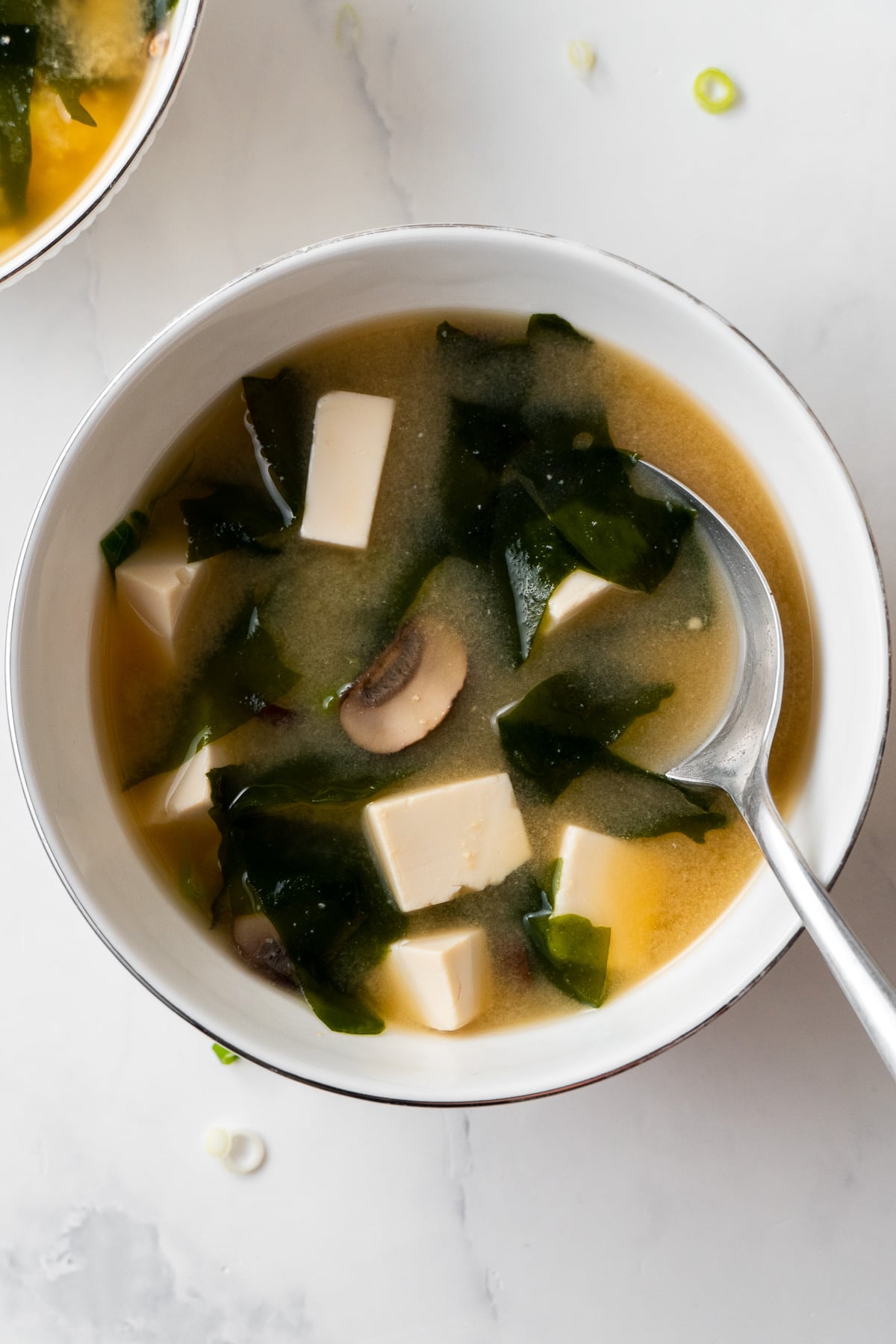
If you’ve ever wondered how to make delicious miso soup at home, I recommend trying this recipe! It’s perfect for making umami-rich and flavor-packed miso soup that tastes just as delicious as the restaurant version.
All you need to whip up this classic Japanese side dish is a few simple ingredients that you can find in any Asian grocery store or online and 10 minutes of your time. It really is that simple.
So the next time you prepare Japanese dishes like teriyaki salmon, be sure to whip up this super easy miso soup to serve alongside your main dish.
Miso Soup Ingredients
To make Japanese miso soup, you’ll need the following ingredients:
- Dashi: Dashi is a seafood stock that is essential for many Japanese dishes. It basically is made by letting katsuobushi (dried bonito flakes) and kombu (dried seaweed) soak in water. There are many great recipes that show how to make dashi at home. But if you don’t want to make your own, I recommend using instant dashi powder. It tastes really delicious and is perfect if you don’t make a lot of Japanese dishes at home. I always keep a box of instant dashi packets in my pantry as they are great whenever you don’t have any homemade dashi on hand. Feel free to use the type of dashi that fits your needs.
- Silken tofu: Another key ingredient for miso soup is tofu. It’s important to use silken or soft tofu. It has a soft consistency and is commonly used for soup recipes. Firm tofu is much denser and is the type of tofu you’d need for making stir fry recipes (it’s the one you press to remove liquid). And if you see a package that states silken and firm on the package, that’s still silken tofu. You can find silken tofu in refrigerators in Asian grocery stores and on the shelves.
- Miso paste: The type of miso paste I’d recommend using is either white or brown miso paste. Both have a rich flavor but are not as intense as red miso paste. White miso paste has a milder flavor while brown miso paste is a little stronger. The only miso paste I wouldn’t recommend using for miso soup is red miso paste as it tastes very strong and too intense. You can distinguish the different types by looking at their color (and the label 😃). The brand I always use is Hikari Miso. You can usually find them in Asian grocery stores in the refrigerator section and online. They taste really great and are used and loved by many people!
- Wakame: Wakame is a type of seaweed that you can buy in Asian grocery stores. It is typically dried and sold in bags that are stored on the shelves. To use it, just rehydrate it by letting it soak in water. If you are looking for wakame, just pay attention to the labels and you’ll find it.
- Mushrooms: I usually use regular brown mushrooms when I make miso soup. But if you prefer shiitake mushrooms, you can definitely buy a bag and use them! And if you don’t like mushrooms at all, feel free to skip them.
- Green onion: Another typical addition is green onions. I love to use them and would recommend adding them to your soup.
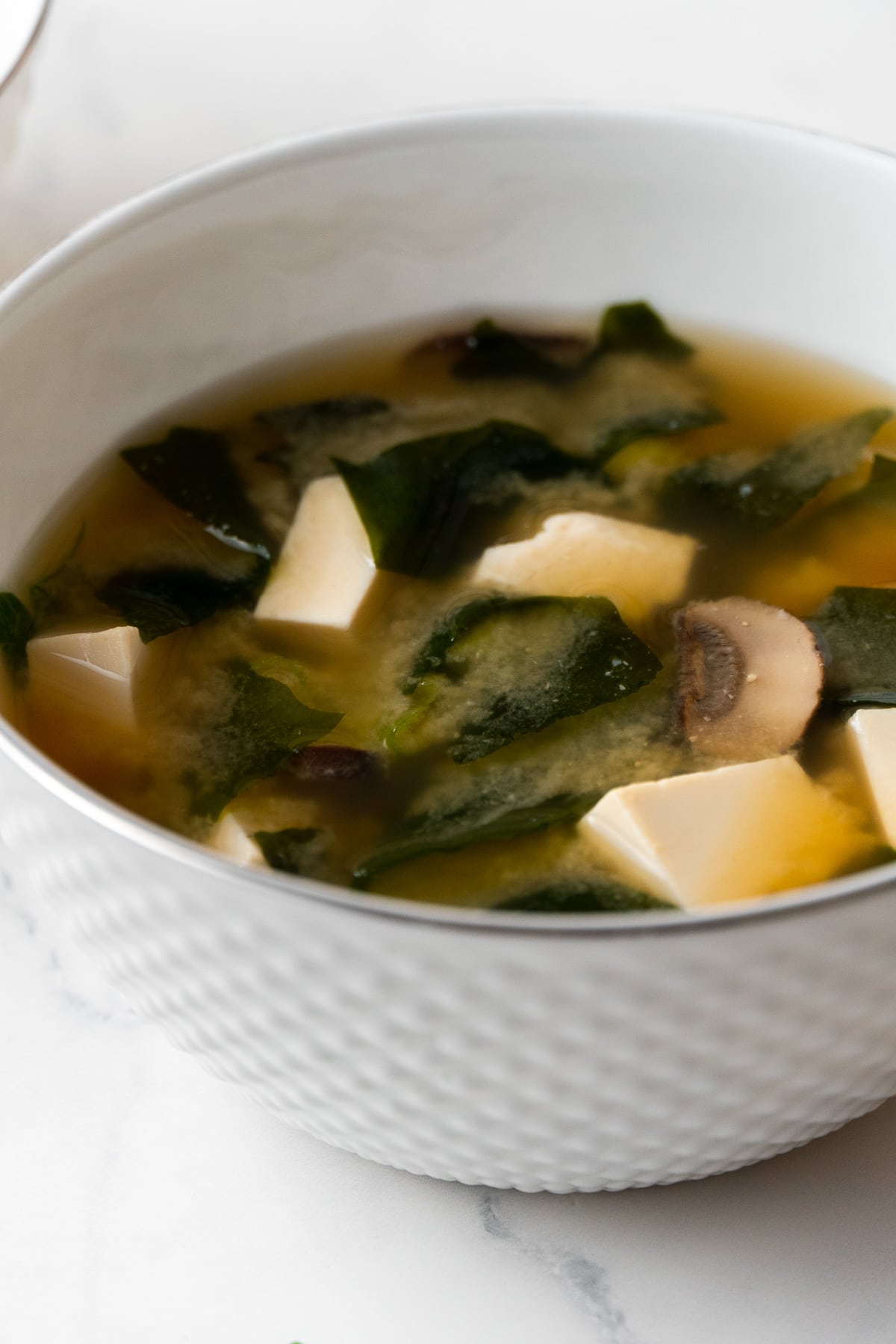
How to make miso soup
Making miso soup is super easy and it only takes 10 minutes! Just follow these steps:
- Cook the mushrooms: First, place the mushroom and dashi in a pot. Cover the pot, bring the soup to a boil, then reduce it to a simmer and let everything cook for 2-3 minutes.
- Rehydrate the wakame: Next, place the dried wakame in a bowl with warm water. When it’s fully rehydrated, drain and set aside.
- Add tofu, wakame, and green onion: Now add the tofu, wakame, and green onion to the soup and let everything heat up for 1-2 minutes. Then lower the heat or turn it off completely to stop the soup from simmering.
- Stir in miso paste: Place the miso paste in a fine mesh strainer. Stir in the miso paste and discard the grainy parts that are left in the fine mesh strainer. Enjoy!
Tips & Notes
Here are a few quick notes that I recommend reading through before you make miso soup for the first time.
- Only use a small amount of dried wakame. I know it’s tempting to use more because it doesn’t look like a lot when it’s still dehydrated. But once the wakame is rehydrated, it gains a lot of size. So be sure to stick to the amounts used in the recipe.
- Make sure you use the right type of tofu. Silken tofu and firm tofu taste very differently. So if you want to make authentic miso soup, be sure to use a package of soft or silken tofu.
- Don’t just dump the miso paste into the pot. Using a fine mesh strainer is really important for the soup’s texture and you’ll like the final result so much more if you use one. I really like to make things quicker and easier by skipping a step when it’s not necessary. But this isn’t one of those times where I’d recommend skipping the step. Plus, it’s kind of satisfying to watch the miso paste slowly dissolve. 😊
- Don’t bring the miso soup to a simmer or boil after you have added the miso paste. This is probably one of the most common mistakes when using miso paste for soups. Miso paste loses its flavor and aroma when you bring the soup to a simmer again. So always lower the heat or turn it off completely. Then add in the miso paste as the last step so it doesn’t lose its flavor. It really makes a difference, so be sure to keep this in mind.
How to serve miso soup
Miso soup is a delicious side dish that goes really well with a variety of dishes and other sides! Here are a few ideas for you:
- Main dish: I love to make miso soup when I make teriyaki salmon or teriyaki chicken wings. I’ll sometimes even make it when I prepare Korean dakgalbi. Miso soup really is one of those side dishes that goes really well with most Japanese and sometimes even Korean main dishes.
- Rice: Another staple in Japanese cuisine is white rice. It’s always served alongside the main dish and miso soup, so I’d recommend preparing a batch of short-grain or medium-grain white rice.
- Vegetable side dishes: I also like to prepare or buy more side dishes that can be added to the meal. It really depends on the dish you serve. I often like to serve pickled radishes, Korean cucumber salad, kimchi, or seaweed salad.
- Dumplings: Another favorite is dumplings. You could make your own gyoza or mandu. Or just buy some in the store and prepare them according to the package instructions. They are a great addition to a variety of meals!
Frequently Asked Questions
The basic ingredients for miso soup are dashi, miso paste, soft tofu, and wakame. Other ingredients, like mushrooms or green onions, are common additions to miso soup.
The base for miso soup is made with dashi and miso paste. Dashi is a Japanese broth made by soaking katsuobushi (bonito flakes) and kombu (a special type of dried seaweed). Miso paste is a fermented soy paste that is incredibly flavorful and delicious.
Miso soup tastes mild yet incredibly flavorful. It is very rich in umami and made with a seafood stock (dashi) that really adds to the flavor of the soup. If you haven’t tried miso soup before, I’d highly recommend making it! It’s an incredibly delicious soup.
Miso soup is made with dashi, a Japanese broth that is made with fish flakes (katsuobushi) and dried seaweed. If you prefer a non-fish broth, you can always use a vegetarian dashi option that is made with mushrooms and dried seaweed. The soup itself has no fish.
This depends on the ingredients you use. If you want to make this recipe gluten-free, you should make sure to buy gluten-free miso paste. Many of the Hikari Miso miso pastes are gluten-free as they are often made with rice. Feel free to check out their website (not sponsored, I just really love their miso paste and they are a popular brand). Dashi and instant dashi is usually gluten-free. Just be sure to read the ingredient list to be on the safer side.
You can store leftover miso soup in an airtight container in your refrigerator for 2-3 days. If you make homemade dashi for your miso soup, you can prepare a large batch and freeze it using an ice cube tray. This way, you’ll always have delicious homemade dashi on hand!
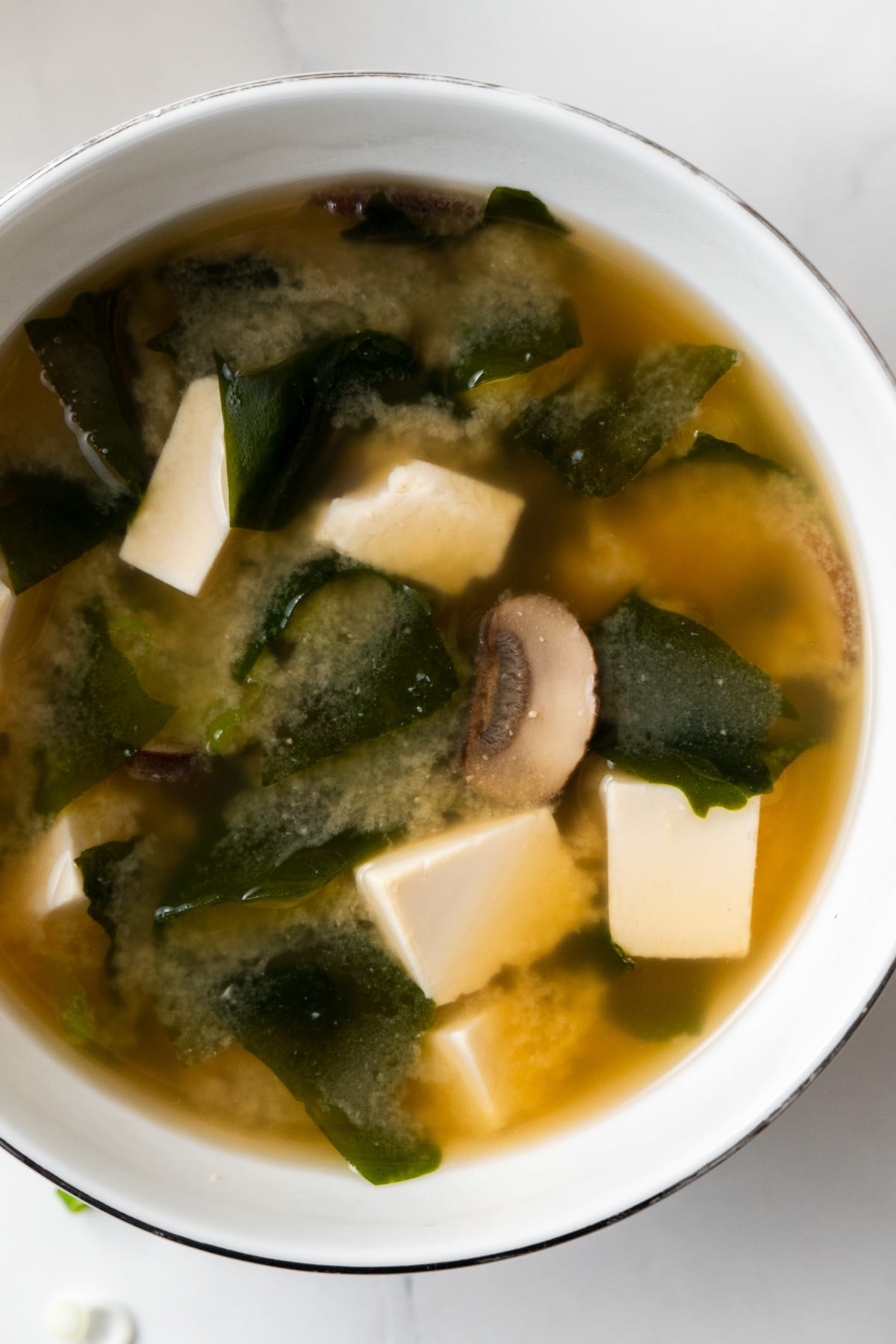
More delicious and simple dinner recipes
If you love Japanese and Korean food, I highly recommend checking out the following recipes. They are super simple to make and taste amazing!
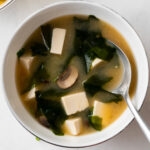
Miso Soup
Ingredients
- 1 ½ cup sliced mushrooms stems removed
- 4 cups dashi instant or homemade
- 1 green onion sliced
- 1 package silken tofu (firm) cut into cubes
- 1 ½ tablespoons wakame
- 4 tablespoons miso paste white or brown
Instructions
- Place the mushrooms and dashi in a pot. Cover the pot, bring the soup to a boil, then reduce it to a simmer. Let the soup simmer for around 2-3 minutes.1 ½ cup sliced mushrooms, 4 cups dashi
- In the meantime, place the dried wakame in a bowl with warm water to let it rehydrate. Then drain and set aside.
- Now add the green onion, cubed silken tofu, and soaked wakame to the soup. Let everything simmer for 1-2 minutes until warmed up. Then lower the heat or turn it off completely so the soup doesn't boil or simmer.1 green onion, 1 package silken tofu (firm), 1 ½ tablespoons wakame
- Next, place the miso paste in a fine mesh strainer. Dissolve the miso paste in the soup by holding it slightly in the pot and stirring with a small spoon. Be sure to catch the grainy parts with the fine mesh strainer and discard them. Enjoy!4 tablespoons miso paste
Notes
- Don't bring the soup to a boil after you added the miso paste as it will make the miso paste lose its flavor.


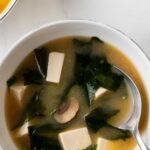
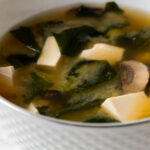

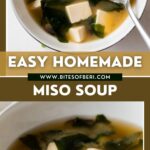
Leave a Reply